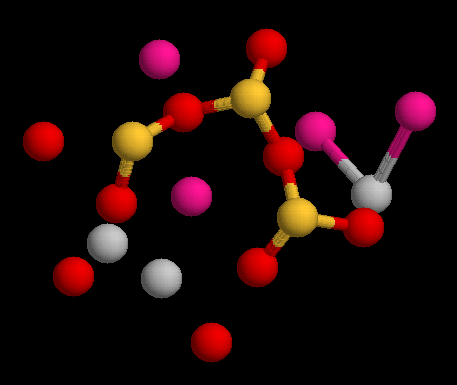|
Tobermorite
Tobermorite is a calcium silicate hydrate mineral with chemical formula: Ca5Si6O16(OH)2·4H2O or Ca5Si6(O,OH)18·5H2O. Two structural varieties are distinguished: tobermorite-11 Å and tobermorite-14 Å. Tobermorite occurs in hydrated cement paste and can be found in nature as an alteration mineral in metamorphosed limestone and in skarn. It has been reported to occur in the Maqarin Area of north Jordan and in the Crestmore Quarry near Crestmore Heights, Riverside County, California. Tobermorite was first described in 1880 for an occurrence in Scotland, on the Isle of Mull, around the locality of Tobermory. Use in Roman concrete Aluminum-substituted tobermorite is understood to be a key ingredient responsible for the longevity of ancient undersea Roman concrete. The volcanic ash that Romans used for construction of sea walls contained phillipsite, and an interaction with sea water caused the crystalline structures in the concrete to expand and strengthen, making that mat ... [...More Info...] [...Related Items...] OR: [Wikipedia] [Google] [Baidu] |
Jennite
Jennite is a calcium silicate hydrate mineral of general chemical formula: Ca9Si6O18(OH)6·8H2O. Jennite occurs as an alteration mineral in metamorphosed limestone and skarn. It typically occurs as vein and open space fillings as a late mineral phase. It also occurs in hydrated cement paste. A first specimen of jennite found in 1966 at the Crestmore quarries (Crestmore, Riverside County, California, US) was analysed and identified as a new mineral by Carpenter in 1966 (Carpenter, 1966). They named it in honor of its discoverer: Clarence Marvin Jenni (1896–1973) director of the Geological Museum at the University of Missouri. In contrast to the first analysis made by Carpenter, jennite was found to not contain appreciable amount of sodium when the Crestmore specimen was reexamined. The structure of jennite is made of three distinct modules: ribbons of edge-sharing calcium octahedra, silicate chains of wollastonite-type running along the b axis, and additional calcium oct ... [...More Info...] [...Related Items...] OR: [Wikipedia] [Google] [Baidu] |
Roman Concrete
Roman concrete, also called , was used in construction in ancient Rome. Like its modern equivalent, Roman concrete was based on a hydraulic-setting cement added to an aggregate. Many buildings and structures still standing today, such as bridges, reservoirs and aqueducts, were built with this material, which attests to both its versatility and its durability. Its strength was sometimes enhanced by the incorporation of pozzolanic ash where available (particularly in the Bay of Naples). The addition of ash prevented cracks from spreading. Recent research has shown that the incorporation of mixtures of different types of lime, forming conglomerate "clasts" allowed the concrete to self-repair cracks. Roman concrete was in widespread use from about 150 BC; some scholars believe it was developed a century before that. It was often used in combination with facings and other supports, and interiors were further decorated by stucco, fresco paintings, or coloured marble. Further inn ... [...More Info...] [...Related Items...] OR: [Wikipedia] [Google] [Baidu] |
Tobermory, Mull
Tobermory (; ) is the capital of, and until 1973 the only burgh on, the Isle of Mull in the Scottish Inner Hebrides. It is located on the east coast of Mishnish, the most northerly part of the island, near the northern entrance of the Sound of Mull. The town was founded as a fishing port in 1788; its layout was based on the designs of Dumfriesshire engineer Thomas Telford. As of 2022 its population was 1,045. It is notable as the location for the 2002–05 children's programme ''Balamory'' by the BBC. Etymology The name ''Tobermory'' is derived from the Scottish Gaelic, Gaelic ', meaning "Mary's well". The name refers to a well located nearby which was dedicated in ancient times to the Mary, mother of Jesus, Virgin Mary. Prehistory and archaeology Archaeological excavations have taken place at Baliscate just outside of the town. The site was first noted by Hylda Marsh and Beverley Langhorn as part of the Scotland's Rural Past. In 2009, it was partially excavated by ''Time T ... [...More Info...] [...Related Items...] OR: [Wikipedia] [Google] [Baidu] |
Calcium Silicate Hydrate
Calcium silicate hydrates (CSH or C-S-H) are the main products of the hydration of Portland cement and are primarily responsible for the strength of cement-based materials. They are the main binding phase (the "glue") in most concrete. Only well defined and rare natural crystalline minerals can be abbreviated as CSH while extremely variable and poorly ordered phases without well defined stoichiometry, as it is commonly observed in hardened cement paste (HCP), are denoted C-S-H. Preparation When water is added to cement, each of the compounds undergoes hydration and contributes to the final state of the concrete. Only calcium silicates contribute to the strength. Tricalcium silicate is responsible for most of the early strength (first 7 days). Dicalcium silicate, which reacts more slowly, only contributes to late strength. Calcium silicate hydrate (also shown as C-S-H) is a result of the reaction between the silicate phases of Portland cement and water. This reaction typically is ex ... [...More Info...] [...Related Items...] OR: [Wikipedia] [Google] [Baidu] |
Tacharanite
Tacharanite is a calcium aluminium silicate hydrate (C-A-S-H) mineral of general chemical formula with some resemblance to the calcium silicate hydrate (C-S-H) mineral tobermorite. It is often found in mineral assemblage with zeolites and other hydrated calcium silicates. C-S-H and C-A-S-H mineral phases are important hydration products of cements but can also be found, although much less frequently, in natural conditions in particular geological environments. The natural specimens are rare and of small size (often available only in limited quantity) but often well crystallised while the hydrated cement phases are disordered and cryptocrystalline or amorphous with a poorly defined stoichiometry denoted by the use of dashes in the abbreviations C-S-H and C-A-S-H. Etymology Tachanarite (pronunciation as ''tă·kherenait'': ) was named by Sweet ''et al.'' (1961) from the Gaelic word ''"tacharan"'', a changeling, ''"an object or a thing left in place of a thing stolen"'' alludin ... [...More Info...] [...Related Items...] OR: [Wikipedia] [Google] [Baidu] |
Calcium Silicate Hydrate
Calcium silicate hydrates (CSH or C-S-H) are the main products of the hydration of Portland cement and are primarily responsible for the strength of cement-based materials. They are the main binding phase (the "glue") in most concrete. Only well defined and rare natural crystalline minerals can be abbreviated as CSH while extremely variable and poorly ordered phases without well defined stoichiometry, as it is commonly observed in hardened cement paste (HCP), are denoted C-S-H. Preparation When water is added to cement, each of the compounds undergoes hydration and contributes to the final state of the concrete. Only calcium silicates contribute to the strength. Tricalcium silicate is responsible for most of the early strength (first 7 days). Dicalcium silicate, which reacts more slowly, only contributes to late strength. Calcium silicate hydrate (also shown as C-S-H) is a result of the reaction between the silicate phases of Portland cement and water. This reaction typically is ex ... [...More Info...] [...Related Items...] OR: [Wikipedia] [Google] [Baidu] |
Silicate Mineral
Silicate minerals are rock-forming minerals made up of silicate groups. They are the largest and most important class of minerals and make up approximately 90 percent of Earth's crust. In mineralogy, the crystalline forms of silica (silicon dioxide, ) are usually considered to be Silicate mineral#Tectosilicates, tectosilicates, and they are classified as such in the Dana system (75.1). However, the Nickel-Strunz system classifies them as oxide minerals (4.DA). Silica is found in nature as the mineral quartz, and its polymorphism (materials science), polymorphs. On Earth, a wide variety of silicate minerals occur in an even wider range of combinations as a result of the processes that have been forming and re-working the crust for billions of years. These processes include partial melting, crystallization, fractionation, metamorphism, weathering, and diagenesis. Living organisms also contribute to this carbonate–silicate cycle, geologic cycle. For example, a type of plankton ... [...More Info...] [...Related Items...] OR: [Wikipedia] [Google] [Baidu] |
Hydrotalcite
Hydrotalcite, or formerly also völknerite, is a layered double hydroxide (LDH) of general formula ·4, whose name is derived from its resemblance with talc and its high water content. Multiple structures containing loosely bound carbonate ions exist. The easily exchanged carbonates allow for applications of the mineral in wastewater treatment and nuclear fuel reprocessing. Structure and discovery It was first described in 1842 for an occurrence in a serpentine–magnesite deposit in Snarum, Modum, Buskerud, Norway. It occurs as an alteration mineral in serpentinite in association with serpentine, dolomite and hematite. The layers of the structure stack in multiple ways, to produce a 3-layer rhombohedral structure (3''R'' polytype), or a 2-layer hexagonal structure (2''H'' polytype) formerly known as manasseite. The two polytypes are often intergrown. Applications Nuclear fuel reprocessing Hydrotalcite has been studied as potential getter for iodide in order to sca ... [...More Info...] [...Related Items...] OR: [Wikipedia] [Google] [Baidu] |
Hydrogrossular
Hydrogrossular is a calcium aluminium garnet series (formula: Ca3Al2(SiO4)3−''x''(OH)4''x'', with hydroxide (OH) partially replacing silica (SiO4)). The endmembers of the hydrogarnet family (grossular, hibschite, and katoite) depend on the degree of substitution (''x''): * grossular: ''x'' = 0 * hibschite: 0.2 < ''x'' < 1.5 * katoite: 1.5 < ''x'' < 3. Hydrogrossular is a garnet variety in which a Si4+ is missing from a tetrahedral site. Charge balance is maintained by bonding a H+ to each of the four oxygens surrounding the vacant site. Hydrogrossular is found in massive crystal habit, sometimes grown in with idocrase. Hydrogrossular is [...More Info...] [...Related Items...] OR: [Wikipedia] [Google] [Baidu] |



